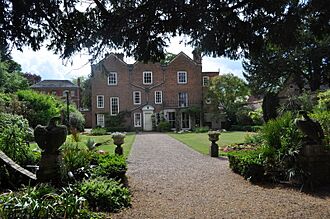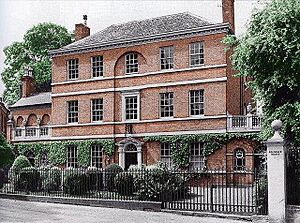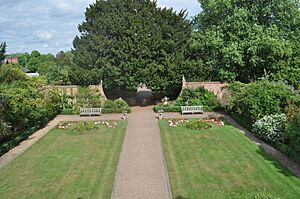Belgrave Hall facts for kids
Quick facts for kids Belgrave Hall |
|
|---|---|

Belgrave Hall: the garden front
|
|
| General information | |
| Status | Heritage venue |
| Type | House |
| Architectural style | Queen Anne-style |
| Address | Church Road, Belgrave |
| Town or city | Leicester |
| Country | UK |
| Coordinates | 52°39′32″N 1°07′30″W / 52.6589°N 1.1249°W |
| Construction started | 1709 |
| Completed | 1713 |
| Client | Edmund Cradock |
| Owner | Leicester Museums |
|
Listed Building – Grade II*
|
|
| Designated: | 5 January 1950 |
| Reference #: | 1074030 |
Belgrave Hall is a beautiful old house in Belgrave, a part of Leicester, England. It was built in the Queen Anne style and is considered a very important historical building. Today, it's a special heritage site where people can visit and learn about the past.
Contents
History of Belgrave Hall
Belgrave Hall was built between 1709 and 1713 by a wealthy merchant named Edmund Cradock. It was his family home, surrounded by lovely walled gardens. Sadly, Edmund and his wife passed away just two years after the house was finished.
Over the years, Belgrave Hall had many different owners. Families like the Simons, Vann, and Ellis families lived there for many decades. In 1936, Leicester City Council bought the house. It was then opened as a museum.
Today, the council uses the house and gardens as a heritage site. This means it's open to the public at certain times, especially during the summer. You can also book it for special events like weddings or even ghost-watching tours!
How Belgrave Hall Was Built
When Belgrave Hall was constructed, Belgrave was a small village. It was about three miles from the city of Leicester. Wealthy business people started building large homes outside the city, and Belgrave Hall was one of the first.
The house has three floors and is made from blue and red bricks. These bricks are laid in a special pattern that looks like a checkerboard. You can see the Cradock family's crest on the lead pipes that carry rainwater. Some of these pipes show the dates 1709 and 1713. This long building time might mean the plans for the house changed while it was being built.
At the front of the house, there are impressive iron gates. They have the letters 'EC' for Edmund Cradock. These gates lead to the main entrance.
The Cradock Family's Time
Edmund Cradock and his wife Anne likely moved into their new home by 1713. However, Edmund died in 1715. His will said that his money and property should be shared among his children.
The house was sold in 1716 to John Simons for £1,350. The Cradock children were not happy with how long it took to sell everything or how much money they received. They even took the people managing the estate to court. However, the house stayed with John and Helen Simons.
Later Owners and Changes
- Simons Family: John Simons owned land across from the Hall, which included orchards. His younger son, Nicholas, inherited Belgrave Hall. He later mortgaged the property and moved away, renting out the Hall. In 1766, the Hall was sold to William Southwell.
- Vann Family: William Southwell and his brother-in-law, William Vann, used the Hall for their stocking-making business. After William Southwell died, the Hall went to his nephews, William and Richard Vann. In 1776, William Vann built a new house nearby called Belgrave House. The gardens were then split between the two properties.
- John Ellis and His Daughters: In 1845, the Belgrave Estate was sold to John Ellis. He was a very important railway businessman and a Quaker. He was also a town councillor and worked to end slavery. He even represented Leicester in Parliament.
John Ellis and his seven daughters moved into Belgrave Hall in 1847. After he passed away in 1862, his wife and five daughters continued to live there. These "Belgrave sisters" were very active in Leicester. They supported the suffragette movement, which fought for women's right to vote. Charlotte Ellis helped manage aid for the poor in Leicester for nine years.
The sisters loved the gardens at Belgrave Hall. They bought more land to expand the parkland and created a woodland garden. One cousin remembered a tiny room with a fireplace by the river, which one of the sisters used as a study. The sisters were known as "public spirited citizens" who were loved in Belgrave and Leicester. Margaret, the last of the daughters, passed away in 1923.
Belgrave Hall as a Museum and Heritage Site
After Margaret Ellis died, the Hall was sold to Thomas Morley. In 1936, the Corporation of Leicester bought it for £10,500. They opened it as a museum and public gardens. The museum was set up to show what a well-off family's home looked like in the 1700s and early 1800s.
In 2005, the museum was updated. It now shows more about the lives of servants and how different their lives were from the wealthy families who lived there during the Victorian era.
The parkland across the road from the Hall is now called Belgrave Gardens. It is open to everyone. The two acres of gardens behind the Hall are also open to the public on certain days during the summer. These gardens still have features that John Ellis first designed in 1850. They include formal gardens, walled kitchen gardens, and glasshouses. Some old buildings have been turned into a "craft village" with small workshops. The gardens also have statues from other old Leicestershire gardens.
Statues at Belgrave Hall
There are four statues remaining from a collection of sixteen that the Vann family bought before 1790. These statues were of mythological figures from Italy. Two of the remaining statues are in the formal gardens. The other two stand near what used to be the gates to Belgrave House.
Paranormal Stories
In 1999, Belgrave Hall became famous for a spooky reason. Two ghostly figures were supposedly caught on security cameras outside the Hall. An organization that studies paranormal events looked at the video. They decided it was probably just a falling leaf, not a ghost. However, they did say they found some "cold spots" in the building.
Even after this explanation, Belgrave Hall remained popular with ghost hunters. The TV show Most Haunted visited in 2003 with celebrity guests. Another show, Fact or Faked: Paranormal Files, also featured Belgrave Hall in 2012. The team from Ghost Hunters International thought the figures might have been people wearing reflective jackets.
See also
- Grade II* listed buildings in Leicester
- List of museums in Leicestershire
- Abbey Pumping Station, Leicester's Museum of Science and Technology (about 1 km south)
- National Space Centre, a space and aerospace museum (about 1 km south)




